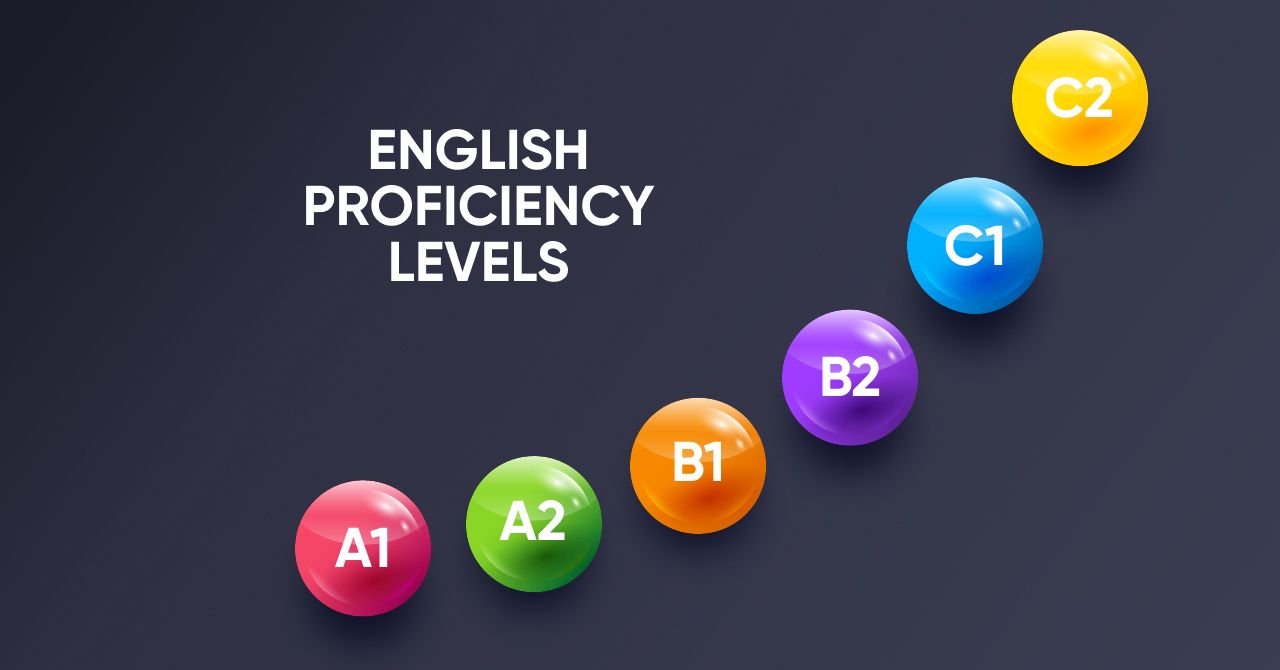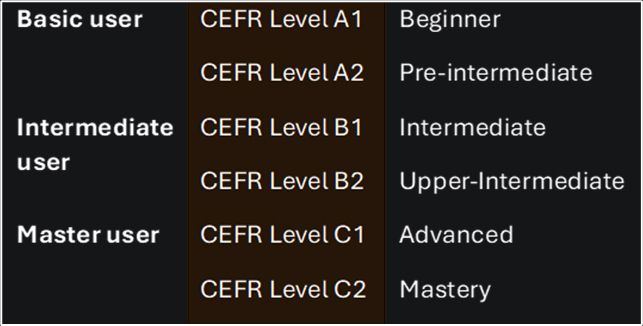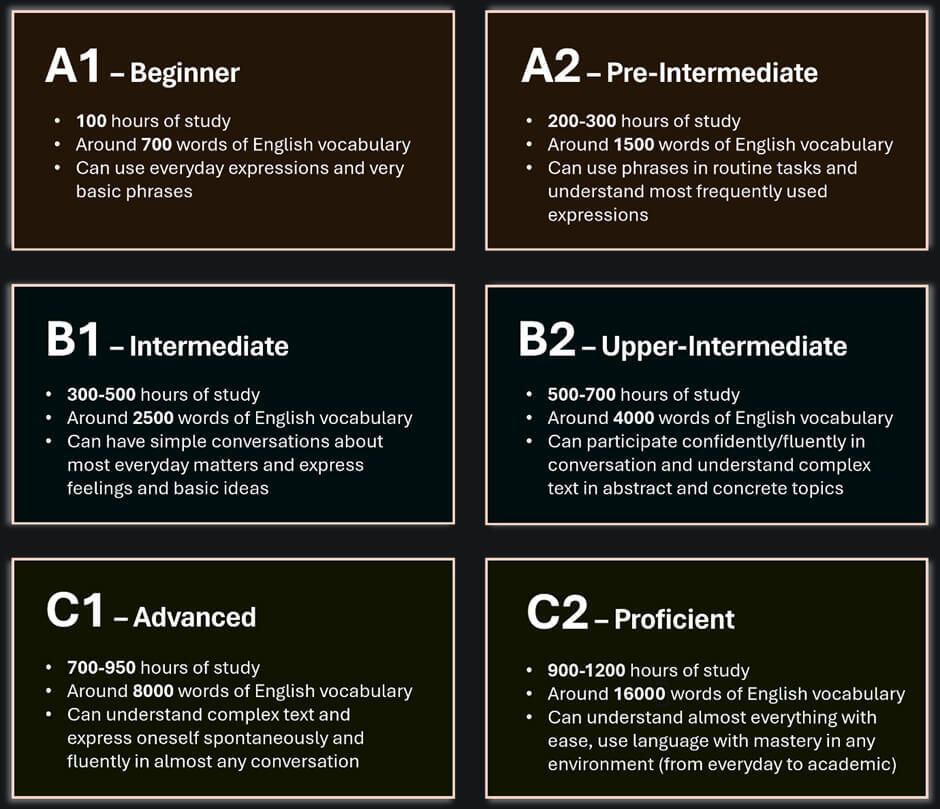
A Detailed Guide to the English Levels of Language Proficiency
The Common European Framework of Reference for Languages (CEFR) establishes 6 levels of language knowledge.
There are many cases where you might need to state your fluency in a language: job interviews, visa applications, cover letters for master’s programs, and the list goes on. Still, what exactly does it mean to be fluent in a language?
Over the years, there have been numerous suggestions as to what constitutes fluency. From trying to define multiple levels of English to claiming that fluency means speaking like a native, opinions are divided.
Or, at least, opinions were divided until the Common European Framework of Reference for Languages (CEFR), which paved the way for an easier definition of what consists of fluency.
In this article, we will go over the CEFR and English language proficiency levels in detail so you know which level you are at, how long it should take to move up a level, and what to expect when you meet your goals.
Check your English proficiency level with our free test in 5 minutes
What is the CEFR?
The Common European Framework of Reference for Languages (CEFR) is, as it says, a non-prescriptive framework for language knowledge. Created in 2011 after decades of research, it is a framework that establishes 6 levels of language knowledge, providing a common reference for what one is expected to know when speaking a language, based on their level of proficiency.
The CEFR levels of language fluency are merely descriptive. That is, you can use them to determine which level you are at, or educators can use them to assess your level so that they can plan their lessons appropriately. The framework does not require anyone to use it in a specific way, and it certainly does not provide a directive for how a teacher or tutor should carry out their lessons. On the contrary, it simply describes what you should know to advance to the next level, regardless of how you choose to learn your preferred language.
Let’s examine these levels one by one for the English language, keeping in mind that they’re pretty much the same for every language but tailored to each language’s characteristics.
The levels of language proficiency according to CERF
According to the CERF guide, for each language, there are 6 levels of proficiency roughly divided into three larger categories: basic knowledge, intermediate knowledge, and proficient knowledge. The table below presents these levels:

Other scales of language proficiency
Aside from the CEFR, there are a few other frameworks that describe 5 levels of English language proficiency. These are:
- The Interagency Language Roundtable (ILR) scale.
- The American Council on the Teaching of Foreign Languages (ACTFL) scale.
Both of these scales have been used in America for decades, but they lack the systematicity that the CEFR provides.
The English levels by CEFR
As we already noted, the content of every CEFR level varies according to the language it describes. Thus, for the English language, each level specifies what you can do and say in English, how many words you know roughly, as well as how many hours are required to achieve this level.

Before we get into the levels in detail, let’s go over what you can expect from each.
How to upgrade to the next English proficiency level
When you understand where you’re now in your path to English fluency, you can get a step-by-step plan to reach the next proficiency level. This helps you understand what you’ll need to improve and which new topics to cover. You can receive such a plan at LiveXP. The Personalized Path is a customized plan for learning English. It is based on your current English level, your goals, and interests, as well as your preferred pace and duration of lessons.
The Personalized Path consists of 1-on-1 lessons with an English tutor and self-study exercises powered by AI. You’ll get fun practice sessions based on your interests, specific topics for every Unit, interim tests, and word sets to learn in every Unit. This highly personalized and interactive method of learning will be your companion in your journey to reach proficiency in English.
To get your Personalized Path, you need to answer a few questions to find out your English level (if you don’t know which one you have, you can pass LiveXP’s free English proficiency test). After you answer a few questions, you’ll get your Personalized Path and see how much effort and time divide you from your goal. Start now, and don’t miss out on this fantastic way to learn English!
A1/A2: Basic user
When you start learning a new language, you follow a few common introductory steps: learn the alphabet and how to pronounce the sounds of the language, learn basic everyday phrases, how to say your name, and so on.
As a basic user, you are still not able to get by on an everyday basis. These English proficiency levels are useful for tourists or expats/immigrants in the first months of residency, but they are insufficient to sustain a long conversation, let alone in work/academic environments.
CERF A1 English level: Beginner
When you begin learning English through a language-learning app or in the first few months of tutoring, you are still approaching level A1, which is the first step in your journey. While you will be able to introduce yourself and answer some basic questions, you will still lack a significant amount of knowledge required to conduct flawless conversations. This includes clumsy interactions, mistakes, pauses, and missed words.
Everyone needs to start somewhere, right? You should not be discouraged by the difficulties of the A1 level but rather strive to learn more!
After approximately 100 hours of study, you will have reached the A1 level, which should take only a few months if you study consistently. Still, your vocabulary knowledge is limited to around 700 words, which is not that much, especially when you consider the lack of grammar and syntax rules knowledge.
What you can do at A1 level
- Introduce themselves and share basic personal information.
- Navigate English-speaking cities, read signs, and ask for directions.
- Order something in a café or restaurant, or shop.
- Describe yourself in simple sentences, including hobbies and interests.
How to reach A1 level
Reaching the A1 level is relatively simple; all you have to do is persevere! Learning a new skill can be especially difficult as we get older. However, because there is so much content available online in various formats for this level of language learning, all you have to do is keep up the momentum. At this level, you can benefit from learning with a tutor on LiveXP, as well as beginner-friendly apps like Duolingo.
CERF A2 English level: Pre-Intermediate
After cruising through the A1 level for a while, you will ultimately reach the A2 level. There, you can easily engage in small talk and express thoughts and opinions. Still, you may only be able to discuss topics of immediate importance, such as shopping or employment, but it’s a step forward! As you learn more about grammar and tenses, prepare to discuss past and future secrets – well, at least with the help of a native speaker.
After an additional 200 hours (for a total of 300 hours), you will have achieved the A2 level. This usually means knowing 1500 English words and understanding grammar well.
What you can do at A2 level
- Make small talk and discuss everyday topics.
- Read and understand texts that contain high-frequency terminology and read through the context.
- Know and understand common phrases related to shopping, weather, geography, employment, and family.
- Describe both their background and the immediate environment.
How to reach A2 level
Reaching the A2 level is much harder than the A1. While it is still at a beginner level, it requires a lot more knowledge, and you are not yet accustomed to the language. You should continue to study and practice but do so more efficiently. It’s an excellent level to begin reviewing with handmade flashcards while also learning English grammar (noun declension, tenses, and verb conjugation).
B1/B2: Independent user
Stepping out of the As and into the Bs indicates that you are now comfortable having a conversation, describing your experiences, and communicating effectively with other learners and native speakers. These are the levels at which you begin to engage in more meaningful conversation and feel confident in further developing your skills. When you get to B2 level, you’re seen as fluent as you can easily talk with people in English-speaking countries.
CERF B1 English level: Intermediate
Raising your status from A2 to B1 English learner indicates that you are now more assured in applying what you have learned in everyday interactions. If you find yourself in an English-speaking country, it will be easier to place an order or communicate with the locals. Of course, you’ll still struggle to discuss unfamiliar topics and make grammatical errors, but your fluency will have greatly improved. You’ve mastered the fundamentals, but you still need to take a few more steps before pursuing a job that requires English or enrolling in an English-speaking university.
At B1, you’ve reached 2500 words, the majority of which you’ll be able to use effortlessly. After an additional 200 hours (for a total of 500 hours), you can also pass the B1 language exams.
What you can do at B1 level
- Understand basic concepts in everyday life.
- Effectively speak to locals while traveling.
- Describe not only events and experiences but also express feelings, fears, ambitions, while providing reasoning.
- Understand English songs and TV shows with subtitles.
How to reach B1 level
Rising from A2 to B1 is easier since you are already accustomed to the language, but it requires more hours of study to expand your knowledge. You will benefit greatly from larger study sessions or tutoring.
CERF B2 English level: Upper-Intermediate
When you reach the B2 level, you are linguistically more advanced than you realize. Even though the level is labeled as upper-intermediate (and the exams are referred to as “Lower”), it is the minimum level at which you can be considered fluent. Reaching the B2 level allows you to not only get by on a daily basis but also to study at university or find work that requires English in most countries.
What B2 shows is that, although you might not be ready to analyze novels like those by Steinbeck deeply, you can comfortably live and work in an English-speaking country.
After an extra 200 hours (for a total of 700 hours), you will have reached the B2 level. Knowing 4000 words and understanding grammar and sentence structure well can help you pass the B2 exams.
What you can do at B2 level
- Comprehend both concrete and abstract concepts, as well as technical vocabulary in their field.
- Converse fluently and spontaneously with native speakers.
- Write detailed texts on a variety of topics from multiple perspectives.
- Understand literature and poetry, but still struggle with overly nuanced language.
How to reach B2 level
After making the relatively easy transition from A2 to B1, the B2 level may feel like you’re not moving as quickly. At this upper intermediate level, it often feels like you’re not making any progress, and you have to push through to keep going because it’s harder to convert knowledge to proficiency. At this point, you should not only pay attention to how native speakers use the language, but you could also benefit from some structured lessons to keep you on track when things seem to be moving too slowly. However, it is worthwhile because, at the B2 level, you are essentially fluent.
Check your English level with our free test and get Personalized Learning Path to reach a higher level.
C1/C2: Proficient user
The final levels of language proficiency are the ones that show the actual proficiency with the language. While it is not required to get by on a daily basis, it will make your life easier because you will now appear to be a nearly native English speaker. These last two levels are your key to proficiency, from academic fluency to understanding the subtle nuances of a language’s metaphorical discourse.
CERF C1 English level: Advanced
The transition from B2 to C1 is perhaps the second most difficult when learning a new language. Because you are already fluent in B2, the additional effort to reach C1 may not appear worthwhile—but it is. Reaching C1 means achieving fluency while also gaining a deeper understanding of English nuances. That means you can easily get humor, irony, and sarcasm, as well as learn and remember idioms and passive-aggressive phrases (useful, right?)
You now know 8000 words. To reach the C1 level, you need to study for an additional 250 hours, making it 950 hours in total.
What you can do at C1 level
- Express themselves fluently, without hesitation, in social, professional, and academic settings.
- Understand metaphorical language, as well as humor and irony.
- Read and fully comprehend longer, complex texts.
- Produce well-structured and detailed texts for various complicated subjects.
How to reach C1 level
Going from B2 to C1 is a difficult process because you are learning idiomatic language, which is difficult on its own, as well as expanding your vocabulary and reading between the lines. While tutoring is always a good idea, at this level, using the English language itself is the best way to learn more English. What I mean is that even if you don’t have to, try to study/read the material in your field of expertise or about your hobbies directly in English. Thus, you become accustomed to the language while also honing other skills.
CERF C2 English level: Master
When you achieve C2, you are considered a master of the language. While you do not yet have the mastery of a native speaker, your English is considered near-native. understand the detailed parts of the language, and use it easily at work or school. You may miss a word or two, but you are fluent enough to work around a different expression.
At the C2 level, your vocabulary exceeds 16.000 words, but you will need more than 1200 hours in total to ensure that you can pass the C2 examinations. In short, if you consistently study and/or take lessons for 5-6 hours per week, it will take you 4-5 years to reach proficiency.
What you can do at C2 level
- Understand (almost) everything written or said.
- Effectively summarize information, (re)construct arguments, and present them in a highly coherent manner.
- Express themselves in a completely fluent and spontaneous way, even handling arguments and questioning.
- Read and produce complex and technical texts across all subjects, recognizing subtle meaning differences.
How to reach C2 level
Moving from C1 to C2 is easier because you already know what you need. Now, you just need to keep learning new words and the ways that native speakers talk. Use the language in everyday, professional, academic, and other situations. By immersing yourself in the language, you will achieve near-native proficiency much faster. Of course, you can always benefit from tutoring, in which an experienced educator walks you through complex literary works and technical texts.
Become fluent with LiveXP’s Personalized Path
If you’re still unsure where to begin and don’t prefer traditional classroom/textbook learning methods, check out LiveXP’s Personalized Path.
The Personalized Path is a program for learning English that is tailored to your current level, goals, and interests, as well as your preferred pace and duration of lessons. Its goal is to provide you with the tools you need to advance to the next level of English proficiency.
I am a native Greek linguist, writer/editor, and academic researcher. I hold a BA in Philology and an MSc in Computational Linguistics from the University of Athens.

